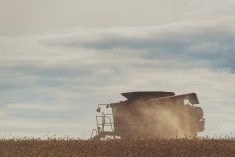CHICAGO (Reuters) — New data showing the U.S. hog herd is shrinking less quickly than feared is small comfort to farmers as their piglets fall victim to a fast-moving virus that has ravaged the country’s arable heartland with no cure or containment yet in sight.
Latest figures from the U.S. Department of Agriculture on Friday make for grim reading, taking the herd to its lowest level in seven years even though the drop was not as bad as forecast. That respite that could bring hog futures prices down from near record highs when trading opens on Monday.
Read Also

Lending policy still focused on primary producers: FCC
Farm Credit Canada said it has not changed its business practices and remains committed to supporting all producers, after a report from an Ottawa-based media outlet claimed otherwise.
But experts worried that the USDA data, which is given voluntarily by farmers, was not showing the full extent of the damage from the virus and warned that prices for spare ribs and bacon could rise as the peak summer season approaches.
Cases of the porcine epidemic diarrhea virus, which is almost always fatal in piglets, have nearly tripled in the last three months. Some estimates suggest as many as five million pigs have died or about eight percent of the U.S. herd.
The virus has also been found in four Canadian provinces.
Friday’s data for the three months to Feb. 28 had been expected to give a more detailed assessment of the impact of the virus, nearly a year after its first appearance in May 2013.
There is no cure for the virus yet but it is highly contagious through pig manure, so farms across North America have tightened up hygiene procedures, forcing trucks to disinfect thoroughly and visitors to change their footwear.
In measures reminiscent of scenes from foot-and-mouth disease outbreaks, farmers are putting up “PED” signs and picking up deliveries from the road, well away from pig barns.
Unlike foot-and-mouth, PED outbreaks do not yet need to be notified to U.S. federal authorities. It is not transmittable to humans, pork is safe to eat and herds can win immunity in a matter of months.
But its devastating impact on hog farming over the last year has pushed prices for pigs ready for slaughter to record highs recently of $131 per hundredweight.
The data from the USDA on Friday showed the hog herd had fallen three percent from a year ago to 62.9 million head. That was well above the average of 61.5 million that analysts in a Reuters poll had forecast.
Some of the decline can be credited to severe cold weather that has hit livestock generally. But the average number of piglets surviving in a litter fell to 9.53 head, below analysts’ forecasts of 9.75 and down from a record 10.08 a year ago, confirming the virus is taking a heavy toll among youngsters.
After the data, analysts said U.S. hog futures on the Chicago Mercantile Exchange could tumble when trading resumes on Monday, possibly by the daily limit of three cents per lb.
But prices are likely to head up again next quarter, experts said, as there will be fewer hogs ready for market just as the peak summer barbecue season demand picks up.
CME futures prices could average $128 per cwt in the second quarter and cling to around $124 in the third, according to Daniel Bluntzer, director of research at Frontier Risk Management, speaking on an industry conference call.
John Nalivka, president of Sterling Marketing Inc., told the same Pork Checkoff conference call that he saw carcass values for the western Corn Belt hitting an average $110 per cwt in the second quarter from $94.50 in the first quarter.
Such high prices are, however, giving farmers record profits, especially with prices for feed languishing around half last year’s levels. Nalivka reckons break even for farmers is about $20 lower than last year.
That is encouraging farmers to keep pigs longer and put more weight on them, with latest figures from the USDA showing the average pig going to slaughter weighs a record 284 lbs up from 275.7 lbs a year ago.
And with even more profits promised later in the year, farmers are likely to invest in producing more pigs into 2015.
“Expectations are prices are going to stay strong,” said Nalivka. “That really sets the tone for expansion.”














